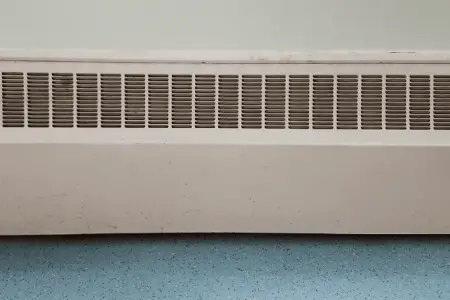Keeping your home warm during the winter season can be tricky, especially when your old baseboard heater is past its best. Luckily for you, there are plenty of alternatives to baseboard heaters that will keep your home nice and cozy during the frigid winter months.
In this article, we’ll talk about three such alternatives to baseboard heaters. All of them can keep your house warm without requiring the invasive ductwork that baseboard heaters are notorious for. Read on to make the right heating choice for your home.
What are baseboard heaters?
There are two types of baseboard heaters. Electric baseboard heaters suck cold air from their surroundings, pass it over hot metal fins and raise its temperature. A built-in small fan then sucks hot air from inside the heater and exhausts it into your room, warming it up.
- FAST HEATING: 1500 Watt heater at 240 Volts or 1125 Watts at 208 Volts...
- LOW SURFACE TEMPS: Lower surface temperature than standard baseboards makes...
- PERFECT FOR BEDROOMS: Reduces effects of airborne allergens while providing...
- ENERGY CONSERVING: Saves energy by retaining heat to generate residual...
- SAFE: Safety feature turns the heater off if normal operating temperatures...
Modern hydronic heaters also run on electricity, but instead of warming the air directly with an electric element, they warm water, oil, or air, which then heats the air. Their operation makes hydronic baseboards more expensive than their electric counterparts.
- USE ANYWHERE DESIGN: This heating unit provides gentle heat with maximum...
- OPTIMAL HEAT: The low-profile design makes it perfect for home use in...
- EASY TO INSTALL: This unit can mount directly to any wall, and flat on the...
- SAFE AND EFFICIENT: This energy-efficient design reduces unnecessary on/off...
- QUIET AND EFFECTIVE: The convection heater operates without the annoying...
Whether in electric or hydronic form, baseboard heaters are seen by homeowners and builders as an ideal replacement (or supplement) to central air systems. However, due to their various drawbacks (discussed below), many users look for alternatives to baseboard heaters.
Drawbacks of Baseboard Heaters
Even the best baseboard heaters suffer from a few drawbacks that may have homeowners considering alternatives. For instance:
- Many of the older baseboard heaters tend to be noisy, making it difficult to use the room where they’re installed for any productive tasks. You can thus ill-afford to install such loud units in noise-sensitive environments such as bedrooms.
- Baseboard heaters need adequate insulation and must be connected to a line voltage thermostat to adjust the temperature automatically. If the connection is lacking, temperature control will be poor and you’d either get too much or too little heat.
- Almost all of them are hot to the touch. Viewed together with the fact that they’re installed in reach of the elderly, children and pets, this makes them a safety hazard. That’s why experts recommend covering your baseboard heaters with covers.
- Baseboard heaters tend to produce very dry heat, which can lead to the irritation of the eyes, nose, throat, and skin. You can counter this issue with a humidifier, but running both the equipment may send your electricity bills through the roof.
What are the Best Baseboard Heater Alternatives?
There are various baseboard heater alternatives, but some of the most popular are ductless heat pumps, wall heaters, and infrared heaters. All three eschew the invasive ductwork that makes baseboard heaters challenging to install, and their overall energy costs are also lower.
Here are the best baseboard heater alternatives:
Ductless Heat Pumps
Ductless heat pumps typically consist of two units: a wall-mounted indoor unit and an outdoor compressor. A conduit, which houses the refrigerant tubing, suction tubing, power cable, and condensate drain, links the indoor and outdoor units.
The compressor draws in air from outside and raises its temperature using a refrigerant, before introducing it to your room via the indoor unit. The absence of ducting makes ductless heat pumps one of the best alternatives to baseboard heaters.
Benefits of Ductless Heat Pumps
- Ductless heat pumps offer more precise temperature control than electric baseboard heaters. You can also control them remotely (and with a remote control) and set them up in different rooms with separate controls for each unit.
- They offer more versatile installation. Unlike baseboard heaters, you don’t have to install a ductless heat pump close to the window. You can suspend them from the ceiling, hang them on a wall, or mount them flush into a drop ceiling.
- Wall-mounted units can be installed as far away from furniture and other household objects as you want, so you won’t have to worry about ductless heat pumps obstructing airflow.
- Ductless heat pumps are a safer option than baseboard heaters. They are always cool to the touch and can thus be used in the proximity of pets, children and the elderly.
- The absence of ducts makes them extremely energy efficient. Duct losses can amount to more than 30% of a baseboard heater’s energy consumption, especially if the ducts are in the attic or any other unconditioned space.
Should You Get a Heat Pump?
Anyone can choose to replace their baseboard heater with a mini-split heat pump. However, keep in mind that they might not be suitable for everyone. Here are the perfect candidates for heat pumps:
- Older homes: They may not always be equipped for duct system installation. Yet, homeowners require up-to-date heating and cooling technology.
- Historic Homes: Heat pumps can provide adequate heating and cooling for these homes without compromising their design or structure.
- Home Add-Ons: If you have a small area of your house or a new home extension that you want to keep warm without retrofitting your entire HVAC system.
Wall Heaters
Also known as wall furnaces, wall heaters are compact heating units permanently mounted on or in the wall of your home. Most of them are powered by electricity, but some also burn fuel to provide warmth. Wall heaters are vented directly through the roof or the wall.
These units work by heating air through an electric heating element or combustion, before blowing out the hot air through their front and into your room being heated. Their relatively simple installation – they don’t require any duct work – and small size makes them ideal for heating small spaces.
Benefits of Wall Heaters
- Wall heaters start working quickly. When installed correctly and with proper safety precautions, most of these units will heat up with 1 to 2 minutes, offering fast and efficient heat to warm-up your indoors.
- They are perfect for supplemental heating. Wall heaters work by using an inexpensive heating device that consumes minimal electricity to heat up the space you’re currently residing in, instead of warming up your entire house.
- Wall heaters allow for complete temperature control. This is a feature you shouldn’t ignore if you want savings on your electricity bills – as without full temperature control, you’d risk increasing or decreasing the heat every few hours, resulting in added costs.
- They provide long-lasting heat. Similar to baseboard heaters, wall heaters provide residual heat that could last for hours, even after you’ve turned off the unit, as long as you don’t have any drafty doors or windows.
- Wall heaters are space-saving. Given that they are mounted directly to the wall, these heaters will leave you with all your floor space. That is the major reason behind individuals living in smaller apartments or condos preferring these type of heaters.
Do wall heaters use a lot of electricity?
Most electric wall heaters consume 1,500 watts. Since 1,000 watts is equal to 1 kilowatt, that means an average wall heater consumes 1.5 kilowatts of power. To figure out how much electricity an average wall heater uses, apply this formula:
Daily electricity consumption = (Heater’s wattage x daily running time) x per unit cost of electricity
Let’s assume you use the heater for 8 hours daily. Applying the number to the formula:
Daily electricity consumption = 1,500 x 8 = 12,000 watts
Finally, divide this number by 1,000 (to convert watts into KW) and multiply number that comes up with per unit charge of electricity. Let’s say you’re paying $0.28 per unit of electricity. Then:
Daily electricity consumption = 12,000/1,000 = 12 KW
Daily electricity consumption = 12 x 0.28 = $3.36
Based on these numbers, running an electric wall heater for 8 hours a day will cost you around $3.36. Extrapolate the figure to a whole month, and you’re looking at a monthly heating bill of around $1000.
Infrared Heaters
Infrared heaters work on the same principle as sun. They emit IR rays that strike with various objects in the room to transfer their heat and warm up your space. This makes infrared heaters super-efficient, regardless of the environmental temperature.
Most infrared space heaters use electricity as fuel. Some, however, also rely on propane and natural gas. The majority of these units are made of ceramic, whereas others are hard-plastic. Hard-plastic IR heaters are more portable than their ceramic counterparts.
Benefits of Infrared Heaters
- Infrared heaters are super-energy efficient. They convert 100 percent of the energy they receive into heat, meaning there are no heat losses. That’s because, unlike other space heaters, infrared heaters do not warm air with heat. Instead, they emit heat directly.
- These units don’t dry up your space. This means you won’t have to deal with problems such as the irritation of the eyes, skin and throat that arise due to dry air. This makes infrared heaters ‘healthier’ than other heaters as they don’t reduce humidity levels in the room.
- Infrared heaters require minimal maintenance. That’s because they have no moving parts, no air filters that require replacement or lubrication, and no motor that will wear out with time. All you need to do to keep them working perfectly is clean their reflectors every now and then.
- These units work quietly. Since infrared heaters don’t emit air (they just radiate light or heat), they don’t use a fan. This makes them super-quiet and an ideal option for noise-sensitive spaces such as bedrooms and living rooms.
- Infrared heaters use a lot less power. Most electric fan heaters consume around 2.0KWh (kilowatts per hour) of power, whereas a standard oil-filled heater draws around 1.0 to 1.5kWH. Infrared heaters, however, use only 0.28 – 0.8 kw/H, depending on the size of their panel.
Can I leave infrared heaters on all the time?
In most cases, it’s safe to leave infrared heaters on all the time. That’s because these units do not emit any gases and, more importantly, usually come with safety shut-off switches that will turn off the unit if it gets too hot or fall-over. Having said that, we still recommend caution if you’re leaving your infrared heater on overnight or while you’re out.
Conclusion
Whether they’re hydronic or conventional, the best baseboard heaters provide you with various benefits. They cost fewer than central air heaters, provide heat 24*7, and are easy to operate. However, their various drawbacks discussed above might force you to look for alternatives.
There are three of them: ductless heat pumps, wall heaters, and infrared heaters. Both the ductless heat pumps and wall heaters are ideal for warming up small spaces. Infrared heaters, depending on the size of their panel, can heat up large spaces, too.

I graduated with a degree in Chemical Engineering and have written for a number of nationally recognized publications in the home improvement space. My skills include fluid mechanics and process engineering and I have worked on numerous projects, including in waste water flow rate calculation and heat balance of steam rollers in the paper industry. My goal as a technical writer is to make complicated topics easy to understand for the average person.


